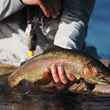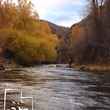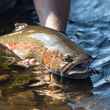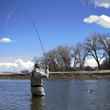Donald Trump has been widely labeled the most anti-environment president in U.S. history, repeatedly portayed as the most dedicated enemy of clean air, clean water, wildlife and public lands this country has ever seated in the Oval Office.
Yet in an era where political discourse has devolved into absurdist fiction, and where wild, unsubstantiated conspiracy theories pervade everyday life, you’d be forgiven for dismissing such labels as hyperbole aimed at damaging Trump's re-election hopes. Unfortunately for defenders of the president, a review of the administration's rollbacks, executive orders and other actions paint a very clear picture. For the past four years, the Trump administration has served as a pry bar in the hands of fossil fuel and extraction industries, industrial agriculture and other moneyed interests that seek to exploit many of the nation’s most beautiful, precious and unique places in the name of profit.
Most certainly Trump has been aided in these efforts by a like-minded Republican Senate. But the majority of the work to dismantle the foundation of U.S. environmental policy and common-sense regulations — designed to protect the air we breathe and the water we drink — has originated as executive action.
Whether through executive orders and memoranda or by working through various federal agencies — which Trump has staffed with industry cronies and former lobbyists like Scott Pruitt, Ryan Zinke, Andrew Wheeler, David Bernhardt, and the illegally appointed William Perry Pendley — the Trump administration has worked to subvert and exploit the public assets it is supposed to manage and protect.
Myriad academic institutions, think tanks, conservation groups and other non-governmental organizations have been cataloguing the administration’s anti-environmental actions since Trump took office in January 2017. These catalogs of rollbacks and deregulations amassed by the Trump administration, in not quite four years, are mind-boggling in breadth and depth.
The list you'll find here is curated and condensed in order to focus on issues most important to the outdoor recreation community. This resource could have easily been three times longer. For those of us that fish, hunt, hike, bike, kayak, climb and more, healthy ecosystems, fish and wildlife populations, and wild places form the bedrock of our outdoor heritage and are vital to its future.
Has the Trump administration been the greatest threat to that heritage in a generation, or perhaps ever? Have a look, and decide for yourself.
Artwork by Jim Houser / @misterhouser.
Trump pushes completion of the Dakota Access Pipeline
Four days after taking office, Trump orders the expedited approval of a pipeline that would travel underneath the Missouri River, threatening the drinking water of the 10,000 member Standing Rock Sioux tribe and disturbing a sacred Sioux burial ground.
Oil and gas companies repeatedly claim that pipelines are safe—that they've taken extreme precautions to ensure this is so. Yet, since 2010, more than 3,300 leaks and ruptures at oil and gas pipelines have been reported. After months of protest by the local Standing Rock Sioux Tribe and native people nationwide, the Army Corps of Engineers denied final approval of the DAP in late 2016. But immediately after taking office, Trump issued an executive memorandum ordering the secretary of the Army to expedite approval of the Dakota Access Pipeline. The now-completed DAP is an 1,100-mile pipeline linking North Dakota oil fields to a river terminal in Illinois. DAP carries 570,000 barrels of crude a day (with plans to increase to 750,000 a day), but faces ongoing legal challenges. Currently before the court is the question: Can the courts shut down an existing, fully operating pipeline? Plaintiffs claim the pipeline is operating illegally. Precedent will probably prevail, but even if it doesn't, this is likely another case where a Trump SCOTUS appointment late in the administration's term will likely resolve the issue, should it go that far. Arguments for the U.S. District Court-DC are due Dec. 18, 2020.
Trump tries to jumpstart Keystone XL
Piping Canadian tar sand oil 1,200 miles through the middle of the US and down to Texas while crossing rivers, streams, and aquifers and the habitats of several endangered species was almost universally excoriated as indefensible, terrible idea—leading the Obama adminsitration to veto construction of the Keystone XL pipeline. Shortly after taking office, the Trump adminisrtation green lights the project.
The Keystone Pipeline is presently stalled by the SCOTUS (July 2020) due to the fast-tracked nature of the development under a January 2017 Trump executive order. Obama didn't veto this pipeline based solely on its ability (or lack thereof) to transport oil to Texas refineries. Rather, his veto was largely in protest against this specific method of extracting oil. Tar-sands oil is the dirtiest oil extracted via the dirtiest process on the planet. Put most simply, tar sands oil extraction involves razing the boreal forest and the peat layer beneath to get at the primordial ooze that happens to burn nicely when it's turned into petrol. Not only is the final product a carbon polluter, but the process emits significant amounts of methane, another greenhouse polluter. The expansion would stretch the pipeline across Montana and SD and into Nebraska.
Two-for-one deregulation
One of President Trump's first executive orders requires federal agencies to repeal two regulations for every newly created one, aimed at increasing corporate profits by reducing costs introduced by pollution-preventing regulations. In 2020, the administration bragged it had far exceeded its goal, killing eight existing regulations for every new one it created
Every federal agency tasked with protecting the public from corporate harm to the environment, public health, public lands, etc., was effectivley ordered to change their mission statements in an effort to weaken the consequences for damaging or destroying those public assets.
Methane rules rolled back
The Trump administration rolls back an Obama-era rule requiring oil and gas companies to monitor and, mostly importantly, limit methane leaks. Methane is responsible for an estimated 25% of all manmade global warming, is the second-largest driver of human-caused climate change, and is up to 84x more potent as a greenhouse gas than carbon dioxide.
In justifying the rollback, Trump's EPA not only touted the $19 million in compliance costs that eliminating methane rules would save the gas industry but went so far as to suggest that the industry would self-regulate methane emissions whether or not the rule was in place. This deregulation was actually opposed by many oil and gas companies as it sullied their marketing campaigns touting natural gas as a "clean" form of fossil fuels. In July 2020, Scientists with the Global Carbon Project reported that methane emissions had reached their highest levels on record.
Stream protection rule repealed
If you think a rule to prevent mining companies from dumping waste from mountaintop removal operations directly into streams and other waterways sounds like a good idea, you're not alone. But killing the rule was part of Trump's promise to "bring back coal," which hasn't worked out so well. While the rules regulating coal companies are more lax now than they've been in generations, Americans, by and large, are rejecting coal as a fuel for power production.
The Stream Protection Rule was developed and implemented to protect waterways from mountaintop removal mining waste, stopping mining companies from dumping pollution that could include chemicals like arsenic and mercury into streams. It’s estimated that more than 2,000 miles of streams in the Appalachian region have been buried through mountaintop removal mining in just the last 30 years. Besides the impact to ecosystems, there are dire health impacts for rural communities. The Stream Protection Rule also ensured that streams damaged by mining activities would be restored at the mining companies expense.
Scott Pruitt named as head of Trump's EPA
As Oklahoma's Attorney General, Pruitt fought EPA regulations from every angle—suing the agency 14 different times—and was rewarded handsomely by the fossil fuel industry in the form of campaign contributions. In years 2010 and 2014, Pruitt ran unopposed and still raked in more than $200K from industry donors. As Trump's EPA head, he was an excellent return on investment until mounting scandals demanded his resignation.
Power corrupts, and it certainly corrupted Pruitt. Perhaps more likely, Pruitt simply brought the corruption with him, given his past relationships with big, extractive industry and his insistence in the courts that the EPA was a bogeyman for business. While in office, Pruitt oversaw and helped carry out several Trump executive orders to rollback environmental regulations (in fact, he is very likely the genesis of many of them). In the end, it was his appetite for excess that killed his tenure at the EPA. He billed taxpayers for lavish personal spending, first-class travel and cozied up the industry lobbyists. He even sought out personal favors, enlisting aides to do his dirty work, so his wife could open a Chick-fil-A franchise. When he resigned in 2018, he claimed it was due to "unrelenting attacks on me personally."
Ryan Zinke heads Trump's Department of Interior
Most folks didn't know what to expect from Zinke, a self-proclaimed Montana outdoorsman who promoted himself as a "Theodore Roosevelt conservative." But it didn't take long to see that Zinke was dedicated not to preserving and protecting the our nation's landscapes and waters, but to opening America's public lands to the oil and gas and mining industries. After a scandal-plagued two years, Zinke resigned in disgrace in 2018.
Zinke helped propose and oversee Interior actions that fly in the face of every Rooseveltian conservationist on the planet, such as touting the drastic reduction of the Bears Ears National Monument and the Grand Staircase-Escalante National Monuments in Utah. Zinke resigned after scandals mounted, not the least of which were conflict of interest allegations that came to the fore over a real estate deal he negotiated with oil giant Halliburton and the leaking of internal DOI emails that revealed that Zinke had lied to and misled the American people about his reasons for shrinking Bear's Ears and Grand Staircase Escalante. Like Scott Pruitt, Zinke blamed his resignation on "vicious and politically motivated attacks."
Unethical hunting practices in Alaska's National Preserves
The National Park Service repeals a rule against deeply unethical tactics—such as shooting animals from aircraft— in targeting bears, wolves, coyotes, caribou and other wildlife in national preserves in Alaska.
Sport and subsistence hunting are generally allowed on Alaska’s nearly 100 million acres of national wildlife refuges and national preserves. But this decision reversed a ban on wildlife killing methods such as: hunting wildlife from aircraft, off-road vehicles, motorboats, motor vehicles, or snow machines; killing swimming caribou; killing brown and black bears over bait; using dogs to chase black bears; and killing bear cubs, female bears with cubs, wolves and coyotes during times when their young are vulnerable. The effects of these liberalized methods of hunting on predator/prey ratios and overall health of the ecosystems are unknown and the PR damage to all honorable hunters is immeasurable.
Chesapeake Bay cleanup defunded
President Trump’s proposed 2018 EPA Budget eliminates funding for Chesapeake Bay, an iconic fishery—and the spawning grounds for 70-90% of the entire Atlantic coast stock of striped bass—on the comeback from near decimation but still under serious threat from pollutants.
Chesapeake Bay is the largest estuary in the United States. As spawning waters for numerous saltwater species, damage to Chesapeake Bay through industrial and agricultural runoff has been detrimental to the ecosystem and its fisheries. Though recovery for some species has happened through conservation efforts, Chesapeake Bay isn’t safe yet. There's some good news, though. While Trump proposed a 26-percent cut to overall EPA operations and threatened to reduce, significantly, the funding for Chesapeake Bay restoration, Congress didn't buy it. In fact, in 2020, Congress boosted funding from $73 million to $85 million. Then, in February 2020 Trump proposed a 2021 budget of just over $7 million. Congress stood up for the Bay again, and upped funding to $90 million.
Trump admin makes it harder for states to block oil and gas projects
Trump's Executive Order 13868 directed the EPA to review and revise section 401 of the Clean Water Act, in order to make easier for oil and gas projects to gain permitting and approval, and harder for states to block those projects when they determine they are a threat to their lands and waters.
According to the National Association of Counties, "Section 401 requires companies to receive certificates from states to build federally-approved infrastructure, like pipelines, within that state’s borders. This section provides states the ability to deny projects if they deem it would have a negative impact on water quality within their jurisdictions, even if the project has received federal approval. Many state groups have expressed concerns that this executive orfer would block states' authorities to regulate pipeline and other energy infrastructure siting projects."
Burnett Oil Company damage "reevaluated"
While providing no justification or evidence, the Army Corps of Engineers backtracks on charges of extensive damage done to Big Cypress National Preserve by the fossil fuel industry.
Just a month after the U.S. Army Corps of Engineers sent a letter to Burnett Oil Company stating that the company’s fossil fuel exploration had caused channelization and done extensive damage to the wetlands of Big Cypress National Preserve, the USACE changed it’s mind. A four-paragraph letter backtracking the accusations, and written by Everglades Restoration Corp Commander Col. Andrew Kelly, provided no explanation as to why. The letter did say that the reversal came after consulting with staff at Big Cypress, though it contained no scientific or legal argument. Regardless of the reversal, the truth on the ground doesn't lie. Giant scars more than 20 feet across and stretching for 100 miles or more tell the real tale. The likely reason for the reversal? The Trump administration's bought-and-paid-for politics that place extraction over habitat at virtually every opportunity. Industry catches a break. People and the environment do not.
Marine National Monuments and Marine Sanctuaries threatened
As part of an effort to increase offshore drilling, Trump issues an executive order that would decimate protections for ocean habitat and wildlife and threaten some of the world’s most pristine ecosystems, which are valued for their biological diversity, importance to scientific research, and their role as economic drivers for coastal communities.
Trump's executive order, titled America First Offshore Energy Strategy, reviews and tries to revise the Outer Continental Shelf Oil and Gas Leasing Proposed Final Program; rescinds the ban on drilling inside Marine Sanctuaries created after July 14, 2008; orders Interior and Commerce to expedite Incident Harassment Authorizations under Marine Mammal Protection Act; requires Commerce to streamline permitting for seismic testing; starts process to review BSEE Well Control and Blowout Preventer Systems rule. The order is a giant gift to extractive industry, giving companies carte blanche to bypass what were widely regarded as traditional, common-sense regulations designed to protect sensitive offshore habitats.
Pebble Mine, back from the dead
Pebble Mine was formally blocked by the EPA in 2014, after years of scientific examination, economic analysis, consultation with Alaskan communities, and comments from hundreds of thousands of Americans asking the government to preemptively stop the mine under the powers granted to it by the Clean Water Act. After receiving pressure from foreign mining companies, other industry representatives, and the Alaskan governor, Trump's EPA announced it would rescind the Obama-era block on mining in the region, once again opening the door to a mine that would gut Bristol Bay, pilfering it for gold, copper and other minerals and leaving behind an estimated 10 billion tons of toxic waste in the middle of an active earthquake zone.
Bristol Bay in southwestern Alaska is home to five species of salmon and the world's largest salmon run. Needless to say, commercial fishing is the region's largest industry. Recreational opportunities abound—fishing, hunting, exploring—that have led to exponential economic growth in the tourism industry as well. And then there's the intrinsic value of a wild place like no other on Earth. Interestingly, EPA directors Scott Pruitt and then Andrew Wheeler along with EPA water chief David Ross must recuse themselves from matters relating to Pebble Mine due to conflicts of interest. After the EPA's repeal of the Clean Water Act block on mining in the Bristol Bay region, the last word from the USACE, published on August 24, 2020, is that the Pebble Mine project cannot be permitted as currently proposed. But it's important to note that this isn't a win for Bristol Bay, its people, or its wildlife. While many in the environmental community were relieved, the Army Corps could very easily approve future Pebble permit applications under the next administration should Trump win a second term. Of note, Northern Dynasty officials were caught on tape in September 2020 espousing their cozy relationships with Alaska's governor, the state's congressional delegation, and were caught saying the mine's lifespan would expand many times past the proposed 20 years. Despite the resignations and the backlash, Northern Dynasty stock is still alive and well. Company shills are now promoting the presence of vital rare earth minerals within the proposed mining footprint.
EPA budget dramatically cut
Trump's proposed 2018 budget, titled “A New Foundation for American Greatness,” slices the Environmental Protection Agency’s budget by 31 percent – a steeper cut than any other agency in the federal government.
Trump's budget cuts are aimed at climate change, air, and water pollution, which should come as a surprise to no one.
Trump announces US withdrawal from Paris Climate Agreement
After withdrawal, the U.S. will join only 7 other nations—Iran, Turkey, Iraq, Eritrea, Libya, South Sudan and Yemen—out of 197 not participating in the Paris Climate accord, a pact between countries that lets developed nations assist developing nations in climate mitigation as well as adaptation to a changing world. It creates a framework for monitoring and reporting climate goals. It’s an agreement with the rest of the world that climate change is the single greatest existential threat to humanity across the board.
There are two sides to the impact of Trump's withdrawal from the Paris Climate Accord — pragmnatic and impactful. Pragmatic: This is an effort by Trump (whether consciously or not) to cede leadership on globally vital issues to other countries under the guise of American exceptionalism and his assumption that nothing will succeed without America's involvement. Impactful: We produce about a quarter of the planet's greenhouse emissions while we only have four percent of the world's population. We have an obligation, on behalf of all mankind, to participate in any effort reduce the production of greenhouse pollution and shift away from the fossil fuels that cause it.
Pacific bycatch limits thrown out
An Obama-era rule proposed by the National Marine Fisheries Service to protect endangered and threatened marine species—including whales, dolphins, and sea turtles—is withdrawn by the Trump administration.
Bycatch limits are aimed at commercial fishing to cap the number of non-target species killed by gill nets. Many of these non-target species are threatened or endangered and under federal protection. There are economic impacts as well. In the short term, this sort of deregulation is great for boosting profits for the commercial fishing industry. But, as we've seen time and again, lax regulations will eventually result in closed fisheries, fewer boats and economic distress. It takes a lot longer to rebuild stocks than it does to drag them down, particularly for long-lived species like groundfish (cod, rockfish, halibut, etc.). Will a second-term Trump be willing to throw money at the commercial fishing industry after it has once again trashed the groundfish stocks? The last time around, it took 20 years to bring the stocks (and the fishing industry) back. It won't take that long to trash them again.
Clean Water Rule repealed, neutering the Clean Water Act
Repeal of the rule removed Clean Water Act protections from headwater streams, wetlands, ephemeral creeks and other small water bodies, despite their immense ecological importance and the fact that we "all live downstream."
By September of 2019, the culmination of an effort begun almost immediately after Donald Trump took office, the Trump administration had finalized its repeal of the the Clean Water Rule. The Clean Water Rule, otherwise known as WOTUS (the Waters of the U.S. rule) was, to anglers and others who recreate on our nations waterways, perhaps the single most important regulatory rule in existence.
Enacted in 2015, the Clean Water Rule clarified and restored longstanding protections under the 1972 Clean Water Act (CWA) after two Supreme Court decisions (in 2001 and 2006) led to years of ambiguity and legal challenges regarding the jurisdiction of the CWA to protect to smaller water bodies—including countless miles of streams, creeks, brooks, wetlands and more.
In 2011, the EPA and the Army Corps of Engineers began a cooperative process in which the two agencies worked together to conduct an analysis of the intended and appropriate jurisdiction of the CWA. The project was exhaustive. According to American Rivers spokesperson Amy Kober, "In the four years that the two agencies worked to craft the rule, they reviewed over 1,200 scientific studies, collected over 1,000,000 public comments, drafted over 6,000 pages of responses, and held over 400 public meetings." The result was the 2015 Clean Water Rule, which clarified that the CWA did extend protections to smaller water bodies like streams, creeks, wetlands and even intermittent and ephemeral water bodies.
Under the guise of preventing "federal overreach," the 2015 rule which required developers to get permits before discharging potential pollutants into small water bodies, wetlands and groundwater was challenged by a myriad of industry opponents such as industrial agriculture, real estate developers, oil and gas companies, and even golf course and country club operators, who claimed the rule was too burdensome and costly for their businesses.
In response to the rule's repeal, Bob Irvin, President and CEO of American Rivers, suggested that "Millions of children newly back to school could give this administration’s officials a basic science lesson: wetlands and streams connect to larger rivers. They are vitally important to protecting water quality for all of our communities. The destruction we cause upstream impacts our neighbors downstream.”
Chris Wood, CEO and president of Trout Unlimited, said the repeal of the rule “could tear the soul out of the Clean Water Act’s protection of small streams and wetlands ... Headwater streams, especially ephemeral streams, are like the capillaries in our bodies – they're small and easy to overlook, but we wouldn’t last long without them. It is a fundamentally flawed final rule.”
BLM takes action to expand fracking on public lands.
Despite increasingly affordable, cheaper renewable energy and a glut of oil and natural gas driving prices down, the administration has engaged in multiple efforts to lease more and more public lands for hydraulic fracturing.
Throughout Trump’s term, the administration has engaged in multiple actions to increase fracking on public lands across the American West. Trump’s BLM has auctioned off leases on millions of acres of public lands, at rates that triple that of the previous administration. The BLM is in charge of subsurface minerals, especially oil and gas, which have been prioritized uses on public lands since the Bush/Cheney administration. But on Forest Service land, the BLM must ask for a USFS review to ensure drilling/fracking doesn't harm irreplaceable above-ground resources. The administration is trying to bypass that requirement, in addition to using speculative leasing practices that are letting land go to drilling companies for as little as $1.50 an acre. All this while more than 65 percent of the USFS land now being leased has very low oil and gas prospects. The administration has also engaged in separate efforts to open millions of acres of public land in California and Colorado, many of which threaten iconic landscapes and are also home to threatened and endangered species.
Sage grouse protections removed
This is the largest action by the Trump administration, to date, that opens federal lands for fossil fuel leasing. It amounts to little more than an attempt to convert nearly 9 million acres of critical habitat for sage grouse—an endangered icon of the West—into cattle pasture and sites for fracking rigs.
Sage grouse are essentially "bycatch" of the enormous expansion of the oil and gas inventory. These birds are among the most sensitive of the grouse species, and, much like their cousins the prairie chicken, they're likely to become among the rarest.
Repeal of Disclosure of Payments rule
Trump nullifies a rule requiring oil, gas and mining companies to publicly disclose payments they make to governments if those payments total more than $100,000 in a year.
EPA announces it will not pursue a rule creating responsibility for environmental damages caused by hardrock mining
The rule would have prevented mine owners or operators from shifting the burden of cleanup to other parties, including the taxpayers, and would have incentivized environmentally sound practices. Unlike the oil, coal and natural gas industries, the hardrock mining industry does not pay royalties to the federal government for minerals extracted from public lands. An estimated half a million hardrock mine sites are abandoned across the U.S. with an estimated price tag of $32 to $72 billion to clean up the most contaminated of those sites.
The Trump EPA says that “modern mining” presents a low risk of taxpayer-funded response, and that the financial assurances regulations are therefore not necessary. Meanwhile, in the West, approximately 40 percent of all headwater streams are polluted in one fashion or another by abandoned mine runoff, and this has been the case for decades. This is a solvable problem, but it can't be fixed until we put an end to the time-honored practice of letting the mining industry off the hook. Congress could help alleviate the problem of abandoned mine pollution by approving the so-called Good Samaritan bill that's been coming before the body for nearly two decades. This would give independent groups the ability to tackle abandoned mine cleanup projects to benefit fish and wildlife habitat without putting the liability burden on the groups trying to do the right thing. The way the law is written now, any entity that takes over a mining site assumes liability for its pollution, even if the intent of that entity is to clean it up. Thus the term "Good Samaritan."
Rollback on mining near Grand Canyon
Though a USDA report says that mining for uranium and other minerals would in fact be a net loss for U.S. revenue; that it would threaten the Colorado River system, public health, and wildlife; and 80 percent of Americans oppose uranium mining in the Grand Canyon region, the Trump administration attempts to roll back a 20-year-old ban.
The Colorado River provides water resources for millions. Why threaten the most precious resource in the West for a project that's doomed to cost taxpayers money? This clearly comes from the "this makes no sense" department. That is, unless you're an energy industry lobbyist and have politicians on the take. Sadly, nearly every resource extraction (or resource substraction, as is the case with national monuments) project proposed or ordered by Trump's office is driven solely by the will of industry and corporate profits.
Climate change removed from list of national security threats
The Pentagon and US Intelligence Agencies believe that climate change is a pressing national security threat.
Rising sea levels, stronger and more frequent oceanic storms, longer more severe droughts that lead to fire seasons stretching over months is just the beginning. The threats to national security are real, existential and growing every year.
Delisting of Greater Yellowstone grizzlies
While carrying capacity for grizzlies in an increasingly human-populated region might be close to maximum, many scientists believe threats — climate change, blister rust on whitebark pines, pestilence and dubious management by state game agencies — still imperil the species.
With approximately 700 grizzlies living within the Greater Yellowstone ecosystem, their recovery was deemed a “success” by the USFWS. While the delisting had been in the works since 2007, there’s a strong case to be made that it finally came to fruition because the argument from states (Wyoming, Idaho, and Montana) wanting to manage grizzlies within their borders (hunt them) found allies in the Trump administration. A much stronger — and scientifically viable — case exists for protecting American grizzlies because of the lack of connectivity to other populations, which tend to occur in pockets, where habitat is best. Ideally, the noble goal of ensuring connected wildlife corridors from "Yellowstone to the Yukon" would come into play, but given the growth in the West, this goal seems more and more like an unattainable dream. For now, protecting what's left is the best option.
Migratory Bird Treaty Act weakened
The Migratory Bird Treaty Act prohibits the killing of protected migratory birds. The Trump administration moves make the killing of protected migratory birds unpunishable—as long as you say you didn't mean to do it.
This whole thing comes down to interpretation of the word "take." The Trump administration says that the word "take" implies intent to kill and that any unintentional bird deaths are merely collateral damage. So if your pipeline leaks into sandhill crane nesting habitat and kills a few dozen cranes, but you weren't expressly trying to kill the cranes, no worries.
Opening the Arctic National Wildlife Refuge to oil and gas exploration
After more than 40 years of failed attempts to open America's greatest wilderness to oil and gas drilling—during which Republicans tried no less than 50 times to open ANWR but repeatedly failed due to an ongoing bi-partisan consensus that drilling was too risky to the ANWR's wildlife, landscapes and native cultures—oil industry pressure on and lobbying of lawmakers finally bore fruit through a provision quietly tucked into the GOP's tax reform plan. The provision opened the long-sought after, 1.5 million acre "parcel 1002" by ordering the Secretary of the Interior to establish an oil and gas plan for the refuge that requires two lease sales within 10 years.
Trump is proud to claim credit for reversing more than 4 decades of bi-partisan protection of the Arctic National Wildlife Refuge, exclaiming "What we’ve done has never been done. If you look at Alaska with ANWR — perhaps the biggest drilling site in the world. Even Ronald Reagan and Bush and Clinton — everybody wanted to get it done — I got it done. ANWR in Alaska — probably or possibly the biggest drilling site in the world."
Drilling on the refuge would impact fish and wildlife (char, grayling, caribou, bears, wolves, etc.), but we don't hear much about how drilling the refuge would impact people. The Gwich'in people of the Arctic have had a symbiotic relationship with the Porcupine caribou herd for millennia. Roading and drilling the refuge would fragment the caribou's habitat, putting in peril a subsistence lifestyle led by indigenous people.
Trump fast-tracked the congressional order to develop an oil and gas leasing plan for the Arctic National Wildlife Refuge coastal plain. In 2017, Interior Secretary David Bernhardt, in support of Trump's wishes to the leasing done sooner than required, noted that there "could be a lease sale by the end of the year." Then, also in 2017, Trump doubled down on leasing the refuge by signing an executive order permitting oil and gas drilling off the coast of the refuge. But, as of August 2020, there still hasn't be a lease sale for any oil and gas tracts on the refuge.
Fossil fuel leases near national monuments
BLM finalizes oil and gas lease sales in southeast Utah near Hovenweep and Canyon of the Ancients National Monuments.
Reduction of Bears Ears, Grand Staircase-Escalante and other national monuments
After completing Trump's requested review of a long list of national monuments throughout the West, former Interior director Ryan Zinke recommends shrinking Bears Ears National Monument by 85 percent, Grand Staircase-Escalante National Monument by 46 percent, along with reductions to Nevada's Gold Butte and Oregon's Cascade-Siskiyou.
Despite repeated claims from Zinke that his recommendation to shrink the monuments was wholly unmotivated by mineral and fossil fuel reserves within their boundaries, going so far as to explicitly state that there "wasn't much" in Bear's Ears, a 2018 investigation that unearthed a litany of clear ties to industry and revealed that many of Zinke’s recommendations in redrawing the borders of Bears Ears and Grand Staircase Escalante were taken nearly directly from requests made by industry representatives in order to provide access to uranium, coal and other reserves within the monuments. The plan for slashing the size of the monuments was met immediately by numerous lawsuits from various environmental groups, outdoor recreation groups, and Native tribes. Even with the cases still in court, the DOI has submitted final plans to the Federal Register.
EPA weakens Regional Haze rules
The Regional Haze Rule and associated regulations have led to major reductions in the emissions of sulfur dioxide, nitrogen oxides, volatile organic compounds (VOCs) and other pollutants. The EPA estimates that from 2007-2018, there was a reduction in sulfur dioxide emissions of 500,000 tons per year and in nitrogen oxide emissions of 300,000 tons per year.
In 1999, the EPA implemented the Regional Haze Rule to improve visibility and air quality at national parks. According to the Harvard Environmental and Energy Law Program, "Since the implementation of the regional haze program, the average visual range has increased from 90 to 120 miles in some western parks and from 50 to 70 miles in some eastern parks. In addition to the benefits for visitors at national parks, the regional haze program delivers public health benefits. The primary pollutants that cause regional haze, including particulate matter, nitrogen oxides (NOx), sulfur dioxide (SO2), and volatile organic compounds (VOCs), are linked to serious health effects including premature death. Some of these pollutants also contribute to acid rain."
The end to efforts to reduce auto emissions
At the the request of automakers, Trump's EPA, under Scott Pruitt, announces the withdrawal of Obama-era fuel efficiency standards that would have produced a 5% annual decrease in tailpipe emissions. Months later, in what has been called "a contender for the most evil document in history," Trump's NHTSA issues new recommendations rolling back CAFE emissions standards, which would effectively put an end to future efforts to reduce emissions. In the document, the administation reviews 8 proposed alernatives, all of which it plainly acknowledges would produce adverse impacts in the areas of air quality, climate change, health, freshwater and ocean ecosystems, water quality and more. Ultimately, the report recommends the most agressive rollbacks, which it openly acknowledges would have the most adverse impacts in each of these areas.
Speaking of the report, the rollback effort, and the GOP's willingness to ignore climate impacts in order to serve the desires of industry, Noam Chomsky told Scientific American, "take a recent publication of Trump’s National Highway Traffic Safety Administration, a detailed study recommending an end to regulations on emissions. It presented a rational argument: extrapolating current trends, by the end of the century we’ll be over the cliff and automotive emissions don’t contribute very much to the catastrophe – the assumption being that everyone is as criminally insane as we are and won’t try to avoid the crisis. In brief, let’s rob while the planet burns, putting poor Nero in the shadows ... There have been many monsters in the past, but it would be hard to find one who was dedicated to undermining the prospects for organized human society, not in the distant future — in order to put a few more dollars in overstuffed pockets."
Scientific Transparency Rule
The proposed rule would only allow the EPA to consider scientific studies in which the underlying data is made publicly available, even if the studies have been peer reviewed or replicated elsewhere.
We believe all scientific research should be made public, but that's another discussion. Public availability does not validate or invalidate peer-reviewed research in any way because science is still science no matter who sees it. This is an attempt at obfuscation with the absurd claim that research can't be accurate and useful if it's behind a paywall.
Clean Power Plan repealed and replaced
The Obama EPA’s move to list greenhouse gases as a threat to public safety and welfare led to the creation of the Clean Power Plan as a tool for the EPA to regulate those emissions. Trump’s EPA replaced the CPP with the Affordable Clean Energy Plan, reducing the responsibilities of the fossil fuel industry under federal law and shifting that burden to states. The cost to public and environmental health is anything but affordable.
Yale Climate Connections said that "preliminary research suggests that the ACE rule will barely reduce carbon emissions more than a scenario with no EPA policy whatsoever." More about rolling back the Clean Power Plan from Yale Environment 360.
The Proposed Cadiz Inc. Groundwater heist
The Cadiz Inc. Groundwater mining proposal would pump 16 billion gallons of water per year from the Mojave Desert and sell it back to the public in plastic bottles. Not only is the groundwater vital to the desert ecosystem, it's also contaminated with a cancer-causing chemical.
Cadiz Inc. first proposed pumping groundwater from the Mojave Desert in the 1990 and environmentalists have fought against it tirelessly from the beginning. A recent study funded by the Mojave Desert Land Trust, a nonprofit conservation group that opposes the Cadiz project, found the proposed groundwater pumping would imperil the largest spring in the southeastern Mojave Desert, a water source for bighorn sheep and other native wildlife along with migratory birds and native plants.
Ban on neonicotinoids and GMOs in National Wildlife refuges rescinded
Despite the fact that the National Wildlife Refuge system is land set aside specifically for fish and wildlife preservation, the Trump administration announced its repeal of the ban on the use neonicotinoids and GMOs within refuges, citing how GMOs help "maximise production" and indicating that neonics could be essential "to fulfil needed farming practices".
The stated mission of the mission of the National Wildlife Refuge System is to "administer a national network of lands and waters for the conservation, management and, where appropriate, restoration of the fish, wildlife and plant resources and their habitats within the United States for the benefit of present and future generations of Americans." But a 2018 memo states that the Refuge System will determine use of GMO seeds and neonicotinoid pesticides on a case-by-case basis. Neonicotinoid pesticdies are proven to have negative affects on birds, other wildlife, and pollinators while certain GMOs pose inherent risk to pollinators. Pollinators are a crucial to the health of every land-based ecosystem in the nation.
Repeal of Endangered Species Act mitigation policies
The Trump administration's removal of this rule dissolves any responsibility charged to the extraction industry for damage to endangered species habitat.
Compensatory mitigation policies meant that any environmental harm caused by the use of public lands that are home to protected species would be offset by environmentally-protective actions. Through compensatory mitigation, DOI could seek a net gain, or no net loss, to natural resources. The order to repeal ESA mitigation policies also instructs agencies to review any existing mitigation policies for burdens on energy development.
James River power project approved
Army Corps grants a permit for Dominion Virginia Power to build 17 obstructive transmission towers across the James River. A primary concern is how this massive development project will affect the James' population of threatened Atlantic sturgeon.
Public lands raked over the coals
DOI overturns the 2016 moratorium on all new coal leases on federal lands in attempt to ressucitate a dirty and already dying industry.
Despite Trump's efforts to end the "war on coal," it's not environmentalists landing the heavy blows. It's the energy market. When Zinke lifted the leasing moratorium on March 29, 2017, coal companies had filed applications to mine 2.7 billion tons. As of March 2020, less than 1.8 billion tons is up for lease, with many of those applications on hold as massive reserves have lasted longer than expected. Still, coal's contribution to greenhouse gases and other environmental issues requires regulation.
EPA disbands air pollution review panel
Under the Clean Air Act, EPA reviewed standards for air quality every 5 years with help from outside experts. While the seven-member committee, officially known as the Clean Air Scientific Advisory Committee has the lead in the process, the review panels provide additional know-how in assessing the relevant scientific literature. The panel’s members are mostly university researchers.
This dissolution took care of two things that the Trump administration seems to have zero tolerance for: science and oversight. While the panels didn't technically serve as oversight, they did offer a sounding board that could have disagreed with agency direction, which has time and again proven to not be directed by science.
Yazoo Pumps resurrection
This 80-year old idea, which has often been called a "zombie project," was axed by the Bush W. Administration by levying the same Clean Water Act provision that the Obama administration attempted to use to protect Bristol Bay from the Pebble Mine. But the Trump administration is attempting to ressurrect the destructive project. With a price tag of $440 million, Yazoo Pumps would drain the 1,550-square-mile Yazoo Backwater Area damaging 200,000 acres of waterfowl habitat in the Mississippi Delta.
In addition to the harm it would cause to 200,000 acres of ecologically important wetland habitat in the Mississippi Delta, the fight over the Yazoo Pumps is also crucial to the question of whether EPA can use its congressionally-provided powers under section 404(c) of the Clean Water Act to protect water supplies and ecologically senstitive areas through preemptive vetoes of large-scale construciton projects such as open pit mining. The EPA has levied that power only 13 times in its history and, up until now, once those protections were put in place, they remained permanent. If the Trump administration is able to overturn the EPA ruling on Yazoo Pumps, it will set a precedent undermining the permanence and power of the 404(c) veto. For more on Yazoo Pumps, read American River's article The zombie project that needs to die.
Fossil Fuel Valuation Rule rescinded
The Department of the Interior rescinds the Obama administration's oil, gas, and coal lease valuation rule, which sought to increase royalties paid to the federal government by companies extracting resources on public lands.
A give-away to the energy industry to ensure — even during a time when renewable sources are cheaper and more plentiful — that the traditional oil and gas industry maximizes profits at every possible turn. Of note, there is active interest in Congress regarding the Public Lands Renewable Energy Act that would require renewable energy projects to pay mitigation fees to make up for their footprints on public lands and any other lost fish and wildlife resources due their construction and operation.
Border wall at national monument and memorial
CBP announces plans to build 18-to-30 foot steel border wall at Organ Pipe Cactus National Monument and Coronado National Memorial on the U.S.-Mexico border.
Where xenophobia and conservation intersect, "The Wall" would very likely impact migratory animals that move north as the weather warms in the spring and cut off traditional corridors for extremely rare animals like jaguars. Of note: the border wall's early infrastructure already bisects the National Butterfly Center near Brownsville and could have the same impact on migratory animals there.
EPA criminal prosecution hits 30-year low
A report by the nonprofit Public Employees for Environmental Responsibility (PEER) found the Environmental Protection Agency's criminal prosecutions under the Trump administration are the lowest in 30 years.
Weakening of the Endangered Species Act
The revisions to ESA include narrowing the definition of the term “habitat,” and allowing federal agencies to conduct an "economic analysis" to decide whether or not a species needs protection. In other words, a species can be removed from protection if that designation gets in the way of making money.
Since the law's passage in 1973, the ESA has saved more than 1,600 species of plants and animals from extinction including the American alligator, bald eagle, gray wolf, grizzlies, hellbenders, pupfish, and Indiana bats. It's been a resounding success for conservation efforts and is still vital to the survival of many species. The weakening of the ESA is simply another tool to open more land up to extraction industries.
Andrew Wheeler nominated as EPA Admin
Former staffer for Jim-“this snowball proves climate change is a hoax”-Inhofe. Former lobbyist for Murray Energy, the nation’s largest privately owned coal company.
During Wheeler’s work as a lobbyist for Murray Energy, the company paid millions in fines for contaminating water in Ohio, West Virginia, and Pennsylvania with coal slurry. According to the New York Times, Murray Energy — while Wheeler's client — produced an “Action Plan” for the Trump Administration that included eliminating the Clean Power Plan, overturning the endangerment finding for greenhouse gases, and eliminating tax credits for wind and solar energy. In his confirmation hearing, Wheeler admitted to having seen the plan.
Revised Blowout Prevent and Well Control Rule
After the Deepwater Horizon disaster, the Department of the Interior created rules to prevent or mitigate any future disasters. Trump's administration seeks to roll them back.
The 2016 Blowout Preventer and Well Control Rule incorporated newer industry standards and adopted reforms in well design, well control, casing, cementing, real-time well monitoring, and subsea containment. The Trump administration’s roll back of these new rules increases risks to offshore oil worker safety and the economic and ecological well-being — outside of fossil-fuel interests — of offshore areas. This Bureau of Safety and Environmental Enforcement is killing a rule designed to keep offshore rigs from spewing crude oil into oceans. It might sound like ironic satire, but sadly, it's true.NPR covers the story here.
Bottled water ban rescinded
In addition to practical reasons, a ban on selling bottled water in our national parks was symbolic of the federal government's awareness of and actions pertaining to mitigation of environmental issues across the nation. Recension of the plastic water bottle ban was an open admission that environmental concerns are of no concern to the Trump administration.
Plastic bottles are one of the worst forms of pollution affecting groundwater, habitat degradation, climate change and more. Also, we don't even need them.Corporate Accountability International noted that the Trump administration had appointed a deputy secretary at the Department of the Interior who previously worked for a law firm representing a large company that sells bottled water just prior to this rollback.
Lifting the Alaska Roadless Rule to boost logging company profits
Trump administration plans to lift the Roadless Area Conservation Rule on all 9.2 million acres of roadless areas of the country's largest national forest. The Tongass National Forest is not only vital to salmon and other fish along the Alaskan Panhandle, it is one of the largest carbon-absorbing forests on the planet. It is, quite literally, the lungs of the continent.
Repealing the Roadless Rule and allowing access to the old-growth timber that stood watch while Capt. James Cook sailed by in 1777 is more evidence that the Trump administration will bend the will of virtually any extractive industry, regardless of what it means for exisiting economies. Logging on the Tongass today provides little in the way of economic activity. The modern Tongass' economy is one of fishing and tourism/recreation. The existing economy is solely dependent upon the intact nature of the country's largest national forest and the symbiotic relationship between the forest and the ocean. They don't call it America's Salmon Forest for nothing.
Weakening the National Environmental Policy Act
NEPA is the bedrock for environmental law at the federal level. In an effort to undermine NEPA's effectiveness, the Trump administration set page count limits for for environmental impact statements and timing limitations for environmental assessments.
The National Environmental Policy Act (NEPA), established in 1969, requires that all federal agencies conduct an assessment of environmental impact prior to any actions taken, placing environmental and public health at the forefront of all decision making. The streamlined rules will also allow agencies to develop categories of activities that do not require an environmental assessment at all and would free federal agencies from having to consider the impacts of infrastructure projects on climate change.
Coastal Barrier Resources Sand Policy revised
The Coastal Barrier Resources Act was passed to limit development of coastal beaches, barrier islands, and marshlands. These areas are crucial to reducing storm surge during hurricanes, and serving as essential habitat for birds and other species.
As climate change raises sea levels and increases both hurricane frequency and strength, the Trump administration reverses a policythat could offer some natural protection from storm surges, encourages even more coastal development, and wrecks habitat for coastal species.
David Bernhardt nominated as Sec of Interior
Just four days after Zinke’s replacement to lead the DOI was appointed, Bernhardt was placed under investigation by the Department of the Interior’s Inspector for ethics violations. Most of those were tied to his years of work as a lobbyist for extraction and agriculture companies.
Coal Ash Rule repealed
EPA proposes to revise Obama-era rules that required companies and utilities to prove that a deposit of coal ash wouldn't harm the environment. Trump's EPA says that demonstration of safety would be required only if the coal ash is dumped in a sensitive location -- floodplains, seismic zones, or unstable areas. The proposal also revises regulations for temporary coal ash piles and groundwater monitoring requirements.
Up to one-third of coal ash is recycled into cement and other products, but the rest is dumped into landfills and surface impoundments. Coal ash contains highly toxic chemicals such as arsenic and mercury, posing serious public and environmental risks when disposed of irresponsibly. The damage to North Carolina's Dan River in 2014 is an example of that risk.
Resurrected sulfide-ore mining on lands bordering the Boundary Waters Canoe Area Wilderness
Though the Boundary Waters are protected from development within its borders, the largest wilderness area east of the Rocky Mountains and north of the Everglades—and home to over 1,100 lakes chock full of smallmouth bass, walleye, lake trout, brook trout, muskellunge, sauger, crappies, bluegills, green sunfish, longear sunfish, pumpkinseeds, largemouth bass, rock bass, lake whitefish, cisco, burbot and yellow perch—is threatened by highly destructive sulfide-ore mining on its boundaries. During the Obama administration, the government declined to renew two Chilean-owned mining leases in Superior National Forest and launched a 20 year study to determine benefits of a 20-year mining ban on lands bordering the BWCAW. Not long after taking office, the Trump administration reversed the Obama-era decision, renewing the mining leases and cancelling the 20-year study.
Scientific and economic studies show that sulfide-ore copper mining along lakes and streams that flow into the Boundary Waters would endanger not only premier fishing, hunting and other recreational activities, but also the sustainable economy of northeastern Minnesota. Sulfide-ore copper mining could lead to the loss of up to 22,000 jobs, $1.6 billion in annual income, and $509 million in private property values. Public comments (of which 94 percent were against mining near the BCWAW) and polling have repeatedly shown that Minnesotans overwhelming want to protect the Boundary Waters.
Read our full coverage: No Worse Place for a Mine.
Proposed road cuts through Gates of the Arctic
The 210-mile Ambler mining road proposal in roadless Northwest Alaska would cut through Gates of the Arctic National Preserve. This could easily be misconstrued as an issue solely about a road, and that is part of the deal, but this is the Pebble Mine nobody is talking about.
The proposed road would bisect the southern quarter of Gates of the Arctic National Park and Preserve (it would cross about 20 miles), and it would cross over 2,900 streams, many of them home to fish like long-distance-migrating king and chum salmon, grayling, pike and inconnu. But the purpose of this road is to access the Ambler Mining District so raw ore can be brought to market via the Dalton Highway or, in more romantic terms, The Ice Road. The mining district is insignificant now, but with a road to haul material to market it would baloon into something of nightmarish proportions and threaten fish, wildlife, and water qualityin the Kobuck and the Koyukuk river drainages.
Before you go
Support from our readers is important. It helps fund the work of our award-winning writers and photographers; our detailed, fact-based and in-depth conservation journalism; our expansive travel stories and much more. If you value the work Hatch Magazine produces, please consider becoming a sustainer for as little as $3.
This is a living document which will be updated regularly as new information becomes available.
The information presented here was compiled through independent research. The excellent work found in deregulation and rollback trackers like those created and maintained by the Harvard Environmental Energy and Law Program, the Sabin Center for Climate Change Law, the New York Times, the National Parks Conservation Society, and the Brookings Institute contributed heavily to this project.































Comments
Jon Burgoyne replied on Permalink
There is so much going on, wave after wave of corruption, that it's so easy to forget the last execrable thing these truly evil men and women are doing. Thank you so much for putting together this scroll of shame.
Walter Goddard replied on Permalink
When I spoke up, about your creativity in spinning the facts against Trump.. Your moderator chose to censor me....
President Trump heeded my advice on Selection Silviculture in forest management, along with fire prevention, protecting the watershed, and the environment..
Here you are again... today, pretending to preserve and protect the environment, yet your leaders, are only trying to destroy America!
All the rolling back, of the Clinton and Obama era rules, is not an attack against the environment... It putting the laws back where they were.. When they laws were adequate... It is part of Trump’s promise, to drain the DC swamp of corruption...
Brian Trussell replied on Permalink
Different wing, same bird.
Look no further than how Democratic Gov. Wolf has handled the fracking industry in PA. He went as far as to allow eminent domain on his constituents.
I dont like Trump but i i really dont like Biden.
If i have to choose between clean water and being socialist i guess ill be fishing for carp more.
Craig replied on Permalink
If you don’t ardently support the protection of our water, air and public lands, then you shouldn’t call yourself a fisherman or hunter and if you support the slime all in the Whitehouse, you definitely do not support those protections.
Brian Trussell replied on Permalink
Insert eye roll
Rocky Bryan Naff replied on Permalink
Trump is 100 times better than the alternative. If you want socialism, move to Cuba or North Korea.
Go ahead, censure me.
Paul Kruse replied on Permalink
Its amazing that seemingly thinking people could just scroll past all the facts presented in this article and dismiss it like it just another day. There is definitely a Cult in this country called Cult 45! As the saying goes the fish rots from the head down and this fish is rotted to the tail!
Pages